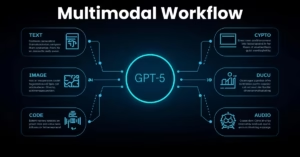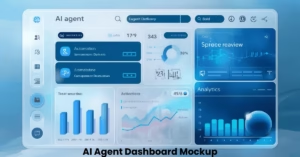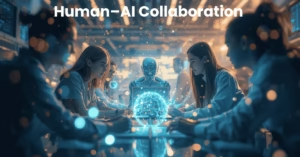Table of Contents
Introduction — From GPT-5 to AGI: why 2026 matters
The transition From GPT-5 to AGI, conversations about AGI (Artificial General Intelligence) isn’t just a flashy marketing tactic — it’s a crucial perspective that researchers, businesses, regulators, and the public are using to rethink how intelligence will be developed, utilized, and regulated in 2026. Following rapid advancements in model scale, multimodality, and agentic systems during 2024 and 2025, 2026 appears to be the year when these technologies shift from the experimental phase to widespread implementation and significant regulation. This guide , highlights the key trends you should keep an eye on, explains why they’re important, and offers insights on how to navigate them.
Trend 1 — GPT-5 maturity: capabilities, multimodality, and real-world reliability. From GPT-5 to AGI
GPT-5, which hit the scene in 2025, marks a significant leap in reasoning, coding, and understanding across different modes compared to earlier versions. Developers are seeing better results with complex coding tasks and multi-step reasoning, while providers are launching variations that focus on speed and deeper “thinking.” These advancements have transformed AI from just a creative assistant into a reliable tool for technical tasks, content creation, and brainstorming. OpenAI+1
Why this matters: With stronger base models come more powerful applications, but this also raises the stakes for safety, the risk of hallucinations in critical areas, and concerns about intellectual property and data responsibility.
Actionable for businesses: What businesses can do: Take stock of where GPT-5-level models are already enhancing workflows (like customer support, code generation, and content operations) and kick off pilot programs that incorporate safety metrics (such as accuracy, hallucination rates, and human oversight).

Trend 2 — The rise of task-specific and persistent AI agents
By 2026, we can expect task-specific AI agents to really take off. Unlike the typical chat assistants we’re used to, these agents will be equipped with memory, plugins, the ability to use various tools, manage schedules, make API calls, and handle autonomous task chains to tackle real-world jobs—think booking travel, negotiating contracts, or keeping an eye on compliance. Analysts are forecasting a significant uptick in the deployment of these agents across businesses. According to Gartner-style predictions, a rapidly increasing portion of enterprise applications will incorporate task-specific agents by 2026. https://www.usaii.org/
Why this matters: These agents transform AI into continuous digital workers that can act, adapt, and coordinate, which will ultimately reshape job roles and boost productivity.
Actionable for product teams: Start by designing pilot programs for agents focused on high-volume, rules-based tasks like procurement and scheduling. Make sure to equip these agents with audit trails and points for escalation.Trend 3 — Multimodal systems: vision + audio + code = richer apps
Models are no longer just text-based. High-performance multimodal models integrate image, video, audio, and code — enabling features like real-time video understanding, document comprehension, and audio-to-action workflows. This pushes new product categories (AI-assisted film editing, multimodal search, automated UX testing). GPT-5 variants and newer models emphasize multimodal fluency, which fuels innovation in creative and industrial domains. OpenAI+1
Why this matters: Multimodality expands use cases dramatically, but introduces privacy, deepfake, and content-moderation risks.

Trend 3 — Multimodal systems: vision + audio + code = richer apps
These days, models are stepping beyond just text. High-performance multimodal models are now blending images, videos, audio, and even code, which opens the door to amazing features like real-time video analysis, document understanding, and audio-driven actions. This evolution is giving rise to exciting new product categories, such as AI-assisted film editing, multimodal search capabilities, and automated user experience testing. The latest GPT-5 variants and other cutting-edge models are focusing on multimodal fluency, driving innovation across both creative and industrial fields. OpenAI+1
Why this matters: Well, while multimodality significantly broadens the range of applications, it also brings along challenges related to privacy, deepfakes, and content moderation.
Actionable for leaders: Incorporate multimodal safety checks (source attribution, watermarking, provenance metadata) into any product roadmap that ingests user media.
Trend 4 — AGI timelines and expert opinion: cautious optimism (and debate)
The conversation around AGI really picked up steam after the breakthroughs in LLMs, leading many experts to revise their predictions for AGI timelines to 2024–2025. Surveys and meta-analyses reveal a wide range of opinions — some believe we could see transformative AGI in just a few years, while others caution that it might still be decades away. While a number of entrepreneurs and researchers are boldly forecasting significant advancements in the near future, mainstream technical evaluations suggest a more measured approach, emphasizing the need for readiness planning instead of assuming AGI is just around the corner. AIMultiple+1
Why this matters: It’s crucial for policy, investment, and business strategies to strike a balance between the potential for rapid advancements and the uncertainty surrounding timelines.
Actionable for policy teams and boards: Actionable for policy teams and boards: Develop scenario-based plans that account for both immediate disruptive capabilities and slower, incremental progress, while ensuring governance remains flexible enough to adapt to changes in capabilities.
Trend 5 — Regulation ramps up: EU, national rules, and auditability
Regulatory frameworks are finally catching up with the rapid pace of AI development. The EU AI Act is being rolled out in stages, introducing obligations like transparency for General Purpose AI (GPAI) and specific rules for high-risk systems, with important compliance deadlines set for 2025 and 2026. Various jurisdictions, including the EU, the UK, and some national agencies, are implementing regulations that impact model transparency, risk assessments, and third-party audits. Providers and those deploying these systems should brace themselves for increased reporting requirements and compliance costs. digital-strategy.ec.europa.eu+1
Why this matters: Compliance is becoming a must for any systems involved in regulated sectors such as healthcare, finance, and safety-critical infrastructure.
Actionable for legal and compliance teams: ke the time to map your AI inventory according to regulatory categories (like GPAI, high-risk, and banned practices) and prepare for necessary documentation, testing, and third-party audits.
Trend 6 — Safety-first R&D: robustness, bias reduction, and red-teaming
As AI models are deployed more widely, the spotlight on their safety grows. Top research labs have rolled out frameworks and stress tests aimed at tackling bias, ensuring political neutrality, and enhancing adversarial robustness. Recent research and internal assessments highlight a strong commitment to minimizing political or social bias while evaluating how models perform under tough prompts. Investing in red-teaming, adversarial testing, and tools for interpretability has become essential for responsible model development. The Verge+1
Why this matters: Trust in AI hinges on clear safety metrics and demonstrable steps to mitigate risks.
Actionable for ML teams: For machine learning teams: Embrace standardized test suites (for bias, safety, and adversarial challenges) and share summary metrics with stakeholders and regulators.
Trend 7 — AI for industry: healthcare, climate, manufacturing
There’s a surge of public and private funding pouring into AI across crucial sectors. Take the EU, for instance, which has rolled out substantial funding aimed at enhancing AI in healthcare, energy, and manufacturing as part of a strategy for sovereignty and resilience. These investments are speeding up the development of specialized AI solutions, like AI screening centers in healthcare and smart manufacturing systems. We can expect to see more collaborations forming between national labs, startups, and established companies. Reuters
Why this matters: Tailored AI solutions can drive productivity improvements, but they also bring about unique safety and data governance challenges.
Actionable for domain experts: Form cross-functional teams that include domain specialists, machine learning engineers, and compliance experts, and start pursuing pilot projects with clear, measurable KPIs.
Trend 8 — The workforce shift: augmentation, displacement, and reskilling
AI agents and automation are set to transform the workplace by taking over routine tasks while enhancing higher-level decision-making. Certain roles, like customer service, basic coding, and content moderation, are particularly vulnerable to swift changes. At the same time, there’s a growing demand for positions that require AI expertise, such as prompt engineers, model operations specialists, and AI ethics officers. To help ease these transitions, it’s crucial for governments and companies to invest in reskilling initiatives.
Why this matters: The social and economic effects are significant — it’s essential to prepare for shifts in talent and to redesign jobs with a human-centered approach.
Actionable for HR and training: Start internal reskilling bootcamps that emphasize AI literacy and look for opportunities to move employees into supervisory and creative roles whenever possible.
Trend 9 — Decentralized and open-source AI ecosystems
The world of open-source LLMs and community-driven models is really taking off, providing some exciting alternatives to the traditional proprietary systems. These initiatives are not just about innovation and transparency; they also make AI more affordable. However, they do bring up some important concerns regarding potential misuse. We can expect to see a blend of ecosystems where businesses combine proprietary services with open models that they’ve customized for specific needs.
Why this matters: Open ecosystems make advanced capabilities accessible to more people, but they also need strong governance to prevent any misuse.
Actionable for CTOs: Keep a risk register for any open models you adapt or implement, and make sure to invest in safeguards and monitoring systems.
Trend 10 — Economics of AI: infrastructure, efficiency, and new business models
When it comes to model efficiency—think parameter efficiency, retrieval-augmented methods, and specialized hardware—these elements will play a crucial role in deploying AI in a cost-effective way. We’re already seeing new pricing and product models pop up, like pay-per-agent, vertical-specialized subscriptions, and fine-tuned model marketplaces, as companies look for more flexible ways to monetize their capabilities.
Why this matters: Well, the cost structures in place will dictate which organizations can roll out powerful AI solutions on a large scale.
Actionable for finance teams: take a fresh look at your cost models for computing, data, and human oversight. It’s time to create total cost of ownership (TCO) projections for your AI projects, making sure to include conservative allowances for safety and compliance.
FAQs
Q: Is AGI coming in 2026?
A: There’s no clear agreement on this — experts have differing opinions. Some believe it could arrive quickly in just a few years, while others advise caution. It’s wise to prepare for rapid advancements in capabilities but don’t assume that full AGI is just around the corner. AIMultiple+1
Q: What should companies do now?
A: Begin by conducting capability audits, launching pilot projects with safety measures in place, understanding regulatory requirements, and investing in reskilling their workforce. It’s also important to keep a record of decisions and metrics to ensure compliance and build trust.
Q: Will GPT-5 become AGI?
A: While GPT-5 is indeed a more advanced and multimodal foundation model, AGI represents a significant leap towards general, adaptable human-level intelligence across various fields. Researchers are actively exploring how to bridge that gap. OpenAI+1
Conclusion — From GPT-5 to AGI: pragmatic readiness beats prophecy
No matter if AGI shows up next year or takes decades, 2026 is set to be a pivotal year: models like GPT-5 will be woven into everyday workflows, intelligent systems will handle ongoing tasks, and regulators will introduce new rules for transparency and safety. The edge will go to those organizations that act now — but they need to do it wisely: measure, audit, and govern effectively. Embrace scenario planning, invest in your team, and prioritize safety as a key product feature.
Call to action (CTA): Take a good look at your AI landscape this quarter: identify where GPT-5–type models interact with your systems, designate risk owners, and develop a 90-day pilot plan for a specific agent use-case that includes human oversight.

- Internal Refrences
- Top AI Trends 2026 You Must Know — AI Trends 2026 Explained.
- Latest Version ChatGPT 2026: GPT-5 Updates & AI Evolution.
- AI Free Coaching Tools for Students & Teachers.
- Future of ChatGPT 2025–2026: GPT-5 Release & AI Roadmap
About the Author
👤 Muhammad Ibrahim – Founder of Mindliftly
Muhammad Ibrahim is a technology writer and wellness advocate who loves to dig deeper into the potential of AI to enhance mental well-being, productivity, and personal growth. An experienced researcher with years of tracking emerging technologies, he brings scientific perspective and actionable strategies to guide readers to understand AI-fueled tools for daily calm and clarity.
Through Mindliftly, Ibrahim offers guides, comparisons, and action plans that link AI innovation to people’s well-being. His vision is straightforward: to enable humans to live more conscious, stress-free lives through responsible and effective use of AI.
📩 Connect with Muhammad:
- Website: Mindliftly.com






